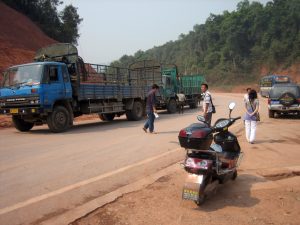Earlier this week, Myanmar and China formally agreed to begin work on an important section of a long-delayed railway project running from Yunnan province to the Indian Ocean.
On January 10, the state-run Myanmar Railways and the China Railway Eryuan Engineering Group (CREEG) signed an agreement to conduct a feasibility study for a stretch of the line running from Mandalay in central Myanmar to the port of Kyaukphyu on the Bay of Bengal.
The announcement, which came a day before Chinese Foreign Minister Wang Yi arrived in the capital Naypyidaw on a four-nation tour of Southeast Asia, follows the completion of a similar feasibility study for an initial section of the line in 2018-19.
The Muse-Kyaukphyu rail project is one of the headline projects of the China-Myanmar Economic Corridor (CMEC), a clutch of infrastructure projects designed to connect China’s Yunnan province with Myanmar’s coasts. In addition to the railway, CMEC, which was established in 2017, features plans for highways, border trade zones, and urban development projects. It also includes two already completed pipelines that pump oil and gas from Kyaukphyu across Myanmar to refineries in Kunming.
The Muse-Kyaukphyu railway project has been on the cards for at least a decade, but progress has been slow, likely due to the high cost of the project – $20 billion by some estimates – and abiding concerns in the Myanmar government and army about China’s true intentions in the country.
The project was suspended by the Myanmar government in 2014, but in 2018, amid the storm of Western condemnation for the situation in Rakhine State, China took the opportunity to press for the project’s revival. That year, the two sides agreed to begin a feasibility study on an initial section of the line running from Muse on the Chinese border to Mandalay.
Given the delays that this project has seen, and the daunting engineering challenges involved in bisecting the Shan hills, we should not leap to the conclusion that construction is imminent.
But it shows that despite a sharp drop-off in overseas Chinese investment due to COVID-19 and increasing geopolitical backlash, Beijing still puts a great deal of stock in deepening its integration with mainland Southeast Asia.
Dating back to the 1980s, Chinese strategists have sought to create economic ties with Myanmar, Thailand, Laos, and Vietnam, both to help develop China’s landlocked southwestern provinces, and also to reduce the country’s heavy reliance on shipments through the crowded Malacca Strait.
Since then, integration has had a transformative impact on the lower Mekong countries. It has broken down the thick barrier of mountains and forests that for much of history kept Chinese power at arm’s length, and supercharged old mule-trading and opium smuggling routes that once linked the two regions. In so doing, it has opened once-remote parts of mainland Southeast Asia to a southward sweep of Chinese investment and immigration that has deepened Beijing’s influence over the region.
Another project that has continued apace despite the challenges of COVID-19 is the Laos-China Railway, which is linking up the Lao capital Vientiane to the China’s high-speed rail network in Yunnan, via 414 kilometers of rugged terrain. Now more than 90 percent complete, the railway is scheduled for completion next year.
Earlier this month, the state-run Vientiane Times also carried stories about the unveiling of the first stage in a new expressway that will run along a similar route to the railway, linking Vientiane with Boten on the Laos-China border. The newspaper described it, in Xinhua-speak, “as part of efforts to strengthen regional connectivity and boost China-ASEAN economic cooperation.”
Similarly, in late September, progress was made in resuming a similarly-delayed Chinese railway project in Thailand, as the Thai cabinet signed off on a $378 million injection of funds for the project.
While the final success of these projects cannot be taken for granted, given the abiding worries about China’s growing influence in the region and parallel concerns about Chinese immigration, it demonstrates Beijing’s determination to further a historic process of economic integration that has already bound it closely to the nations to its south. Indeed, this could well be described as China’s long-term strategy in the Mekong region: economic integration as a prelude to ever-deepening political relationships.

































